
KiCad Nightly Referenzhandbuch
Copyright
Dieses Dokument unterliegt dem Copyright © 2025 der unten aufgeführten Mitwirkenden. Sie dürfen es unter den Bedingungen der GNU General Public License (http://www.gnu.org/licenses/gpl.html), Version 3 oder höher, oder der Creative Commons Attribution License (http://creativecommons.org/licenses/by/3.0/), Version 3.0 oder höher, verbreiten und/oder verändern.
Mitwirkende
Jean-Pierre Charras, Graham Keeth
Feedback
Das KiCad-Projekt freut sich über Rückmeldungen, Fehlerberichte und Vorschläge in Bezug auf die Software oder ihre Dokumentation. Weitere Informationen zum Einreichen von Feedback oder zum Melden eines Problems finden Sie in den Anweisungen unter https://www.kicad.org/help/report-an-issue/
Version der Software und Dokumentation
Dieses Benutzerhandbuch basiert auf KiCad 9.99. Funktionalität und Aussehen können sich in anderen Versionen von KiCad unterscheiden.
Revision der Dokumentation: f0f53076.
Einführung in den KiCad-Zeichnungsblatteditor
Der Zeichnungsblatteditor ist ein Werkzeug zum Erstellen von benutzerdefinierten Zeichnungsblättern zur Verwendung in den KiCad-Schaltplan- und Leiterplatteneditoren. Zeichnungsblätter können benutzerdefinierte Titelblöcke, Rahmen, Logos sowie andere Texte und Grafiken enthalten.
Der Rahmen, das Schriftfeld und andere grafische Elemente (Logos) werden zusammen als Zeichnungsblatt bezeichnet.
Grundlegende Zeichnungsblattelemente sind:
-
Linien
-
Rechtecke
-
Text (mit Schlüsselwörtern, die durch den eigentlichen Text ersetzt werden, wie z.B. das Datum, die Seitenzahl…) im Schaltplan- oder Leiterplatteneditor.
-
Multipolygone (hauptsächlich zum Platzieren von Logos und speziellen grafischen Formen)
-
Bitmap Grafiken.
| Bitmaps können nur von wenigen Plottern geplottet werden (nur PDF und PS). Daher wird bei anderen Plottern nur ein Begrenzungsrahmen geplottet. |
-
Elemente können wiederholt werden, und Text und Polygone können gedreht werden.
Zeichnungsblatteditor-Dateien
Der Zeichnungsblatteditor liest und schreibt KiCad-Zeichnungsblattdateien (.kicad_wks). Diese Dateien können als benutzerdefinierte Zeichenblätter für Schaltplan- und Leiterplattenentwürfe verwendet werden, indem ein benutzerdefiniertes Zeichenblatt im Dialogfeld Seite einrichten in jedem Editor ausgewählt wird.
Wenn der Zeichnungsblatteditor zum ersten Mal geöffnet wird, zeigt er das Standard-KiCad-Zeichnungsblatt an, bis eine andere Zeichnungsblattdatei geöffnet wird.
Ablaufplan
Grundlegende Eigenschaften von Zeichnungsblattelementen
Grundlegende Zeichnungsblattelemente sind:
-
Linien
-
Rechtecke
-
Text (mit Schlüsselwörtern, die durch den tatsächlichen Text ersetzt werden, wie z.B. das Datum, die Seitenzahl…) im Schaltplan- oder PCB-Editor.
-
Multipolygone (hauptsächlich zum Platzieren von Logos und speziellen grafischen Formen). Diese Polygone werden mit dem Werkzeug Bildumwandler erstellt und können nicht im Zeichnungsblatteditor erstellt werden, da es nicht möglich ist, derartige Formen von Hand zu erstellen.
-
Bitmap Grafiken zur Platzierung von Logos.
| Bitmap Grafiken können nur von einigen Plottern gezeichnet werden: nur PDF und PS. |
Zusammengefasst:
-
Texte, Multipolygone und Bitmap Grafiken werden durch eine Position definiert und können gedreht werden.
-
Linien (tatsächlich Segmente) und Rechtecke werden durch zwei Punkte definiert: einen Startpunkt und einen Endpunkt. Sie können nicht gedreht werden (was für Segmente auch nutzlos wäre).
Diese Basisemente können wiederholt werden.
Wiederholter Text erlaubt auch einen Inkrementwert für Beschriftungen (hat nur Bedeutung, wenn der Text aus einem Buchstaben oder einer Ziffer besteht).
Koordinaten-Definition
Jede Position, jeder Startpunkt und jeder Endpunkt von Elementen ist immer relativ zu einer Seitenecke. Mit dieser Funktion können Sie ein Zeichnungsblatt definieren, das nicht vom Papierformat abhängig ist.
Referenzpunkte und Koordinaten:
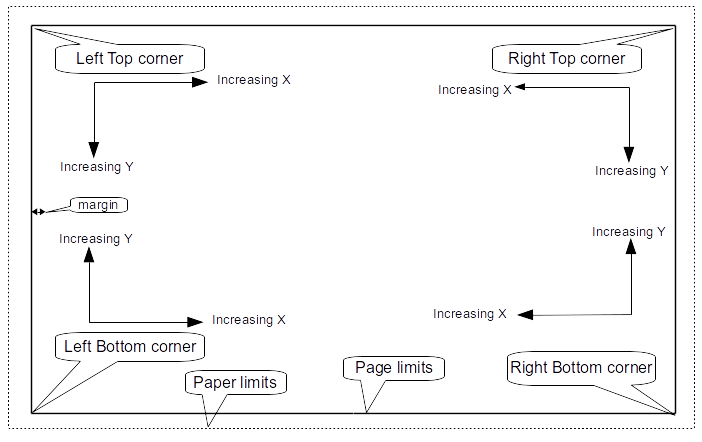
-
Wenn die Seitengröße geändert wird, ändert sich die Position des Elements relativ zu seiner Referenzecke nicht.
-
Normalerweise werden Titelblöcke in der rechten unteren Ecke angebracht, daher ist diese Ecke die Standardecke beim Erstellen eines Elements.
Bei Rechtecken und Segmenten, die zwei definierte Punkte haben, hat jeder Punkt seine Referenzecke.
Rotation
Elemente, deren Position durch nur einen Punkt definiert ist (Text und Polygone), können gedreht werden:
Normal: Rotation = 0

Gedreht: Rotation = 20 und 10 Grad.
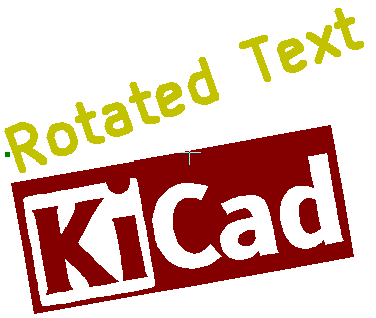
Wiederholungsoption
Elemente können wiederholt werden:
Dies ist nützlich, um Raster und Rasterbeschriftungen zu erstellen.

Text und Schlüsselwörter
Schlüsselwörter
Text kann aus einfachen Zeichenfolgen bestehen oder Schlüsselwörter enthalten.
Schlüsselwörter werden durch konkrete Werte ersetzt, wenn das Zeichnungsblatt in einem Schaltplan oder PCB-Design verwendet wird. Sie verhalten sich wie Textvariablen in den Schaltplan- und Platineneditoren, mit dem Unterschied, dass die Werte entweder automatisch vom Editor oder vom Benutzer im Dialogfeld „Seite einrichten“ des jeweiligen Editors festgelegt werden.
Die Syntax für Schlüsselwörter lautet ${KEYWORD}. Das Schlüsselwort, einschließlich der umgebenden ${}, wird durch den Wert des Schlüsselworts ersetzt.
| Schlüsselwortname | Beschreibung |
|---|---|
|
Versionsnummer von KiCad. |
|
Blattnummer. |
|
Gesamtzahl der Blätter. |
|
Inhalt des Feldes |
|
Inhalt des Feldes |
|
Dateiname der Schaltplan- oder PCB-Designdatei mit Dateiendung. |
|
Inhalt des Feldes |
|
Name der aktuellen PCB-Lage. Dieses Feld ist im Schaltplan- und Board-Editor leer. Es wird nur in Plots von PCB-Designs angezeigt. |
|
Papierformat des aktuellen Blattes, das in den Seiteneinstellungen festgelegt ist. |
|
Inhalt des Feldes |
|
Blattname des aktuellen Blattes. Im Platineneditor ist dieses Feld leer. |
|
Blattpfad des aktuellen Blattes. Im Platineneditor ist dieses Feld leer. |
|
Inhalt des Feldes |
Beispielsweise wird bei Größe: ${PAPER} „Größe: A4“ angezeigt, wenn das Papierformat auf A4 eingestellt ist.
Wenn der Vorschaumodus aktiv ist ( ![]() ), wird der Titelblock wie im Schaltplan- und Platineneditor angezeigt, wobei Schlüsselwörter durch die entsprechenden Werte ersetzt werden. Sie können die angezeigten Werte im Dialogfeld „Seitenvorschau-Einstellungen“ konfigurieren (
), wird der Titelblock wie im Schaltplan- und Platineneditor angezeigt, wobei Schlüsselwörter durch die entsprechenden Werte ersetzt werden. Sie können die angezeigten Werte im Dialogfeld „Seitenvorschau-Einstellungen“ konfigurieren (![]() ).
).

Wenn der Bearbeitungsmodus aktiv ist (![]() ), wird der Titelblock ohne Ersetzen der Schlüsselwörter angezeigt.
), wird der Titelblock ohne Ersetzen der Schlüsselwörter angezeigt.

Mehrzeiliger Text
Text kann mehrzeilig sein.
Es gibt zwei Möglichkeiten, eine neue Zeile in einen Text einzufügen:
-
Fügen Sie die Zeichenfolge
\nein (hauptsächlich im Dialogfeld „Seiteneinstellungen“ in KiCad). -
Fügen Sie eine neue Zeile im Designfenster vom Zeichenblatteditor hinzu.
Hier ist ein Beispiel:
Einrichtung

Ausgabe
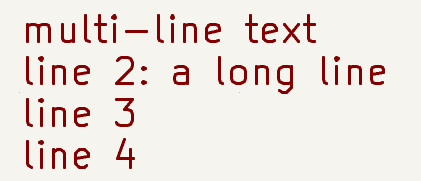
Mehrzeiliger Text im Dialog 'Seiteneinstellungen'
Im Dialog 'Seiteneinstellungen' akzeptieren Textsteuerelemente keinen mehrzeiligen Text.
Die Zeichenfolge \n sollte eingefügt werden, um einen Zeilenumbruch innerhalb eines Textobjekts zu bewirken.
Hier ist ein zweizeiliges Textobjekt im Feld 'Kommentar2':

Hier ist der eigentliche Text:

Wenn Sie jedoch tatsächlich das Zeichen \n innerhalb des Textes benötigen, geben Sie \\n ein.

Und der angezeigte Text:
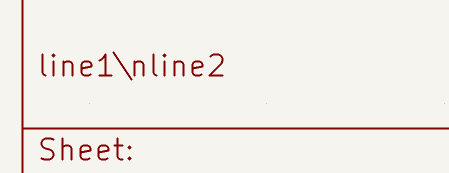
Einschränkungen
Einschränkung auf Seite 1
Bei der Arbeit mit dem Schaltplaneditor umfasst der vollständige Schaltplan oft mehr als eine Seite.
Normalerweise werden Zeichnungsblattelemente auf allen Seiten angezeigt, aber Sie können auch festlegen, dass jedes Element nur auf der ersten Seite oder auf allen Seiten außer der ersten Seite angezeigt wird. Um zu ändern, auf welchen Seiten ein Element angezeigt wird, verwenden Sie das Dropdown-Menü im Bereich Elementeigenschaften des Elements. Die Optionen sind: Auf allen Seiten anzeigen, Nur auf der ersten Seite und Nur auf den folgenden Seiten.

Maximale Textgröße
Textelemente haben eine maximale Größenvorgabe. Sie können eine maximale Höhe und eine maximale Breite festlegen, die zusammen einen Begrenzungsrahmen bilden, der die maximale Größe des Textobjekts definiert.
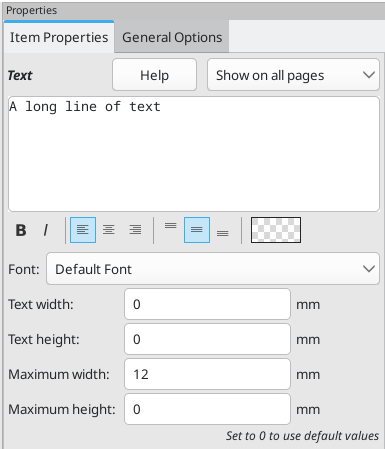
Wenn das Textobjekt größer als die maximale Größe in einer bestimmten Dimension ist, wird das Textobjekt in dieser Dimension dynamisch gestaucht, damit es in den Begrenzungsrahmen passt. Dies führt zu einer optischen Verzerrung des Textes. Wenn der Text in den Begrenzungsrahmen passt, wird er nicht gestaucht.
Wenn einer der beiden Parameter auf 0 gesetzt ist, erzwingt KiCad keine maximale Größe in dieser Dimension.
Ein Text, dessen maximale Höhe und Breite auf 0 gesetzt sind:

Der gleiche Text komprimiert, da die maximale Breite kleiner als die Breite des Textes gesetzt ist:

Aufrufen des Zeichnungsblatteditors
Der Zeichnungsblatt-Editor wird in der Regel über eine Befehlszeile oder über den KiCad-Projektmanager aufgerufen.
In der Befehlszeile lautet die Syntax pl_editor <*.kicad_wks-Datei>.
Befehle des Zeichnungsblatteditors
Hauptfenster
Das Bild unten zeigt das Hauptfenster des Zeichnungsblatteditors.

Der Hauptteil des Bildschirms ist die Bearbeitungsfläche für das geöffnete Zeichenblatt.
Der rechte Bereich ist ein Eigenschafteneditor zum Bearbeiten des ausgewählten Elements. Er wird nur angezeigt, wenn ein Element im Arbeitsbereich ausgewählt ist.
Symbolleiste des Hauptfensters
Die obere Symbolleiste ermöglicht einen einfachen Zugriff auf die folgenden Befehle:
|
Ein neues Zeichnungsblatt erstellen. |
|
Eine Zeichnungsblattdatei laden. |
|
Das aktuelle Zeichnungsblatt in einer |
|
Die Blattgrößenauswahl und den Editor für Anwenderdaten im Schriftfeld anzeigen. |
|
Die aktuelle Seite drucken. |
|
Rückgängigmachen/Wiederherstellen. |
|
Vergrößern, Verkleinern, Neu zeichnen und Auto. |
|
Zeigt das Zeichnungsblatt im Vorschaumodus an: Der Text wird wie im Schaltplan- oder Platineneditor angezeigt, wobei Text-Schlüsselwörter durch Benutzerttext ersetzt werden. |
|
Das Zeichnungsblatt im Bearbeitungsmodus anzeigen: Der Text wird „wie er ist“ angezeigt, ohne dass Schlüsselwörter ersetzt werden. |
|
Auswahl der Referenzecke für die in der Statusleiste angezeigten Koordinaten. |
|
Auswahl der Seitenzahl (Seite & oder andere Seiten). Diese Auswahl ist nur dann von Bedeutung, wenn einige Elemente, die über eine Seitenoption verfügen, nicht auf allen Seiten angezeigt werden (z. B. in einem Schaltplan, der mehr als eine Seite umfasst). |
Befehle im Zeichnungsbereich
Tastaturbefehle
F1 |
Hineinzoomen |
F2 |
Herauszoomen |
F3 |
Anzeige aktualisieren |
F4 |
Cursor in die Mitte des Anzeigefensters bewegen |
Home |
Footprint an Anzeigefenster anpassen |
Leertaste |
Relative Koordinaten auf aktuelle Cursorposition setzen |
Pfeil nach rechts |
Cursor um eine Rasterposition nach rechts bewegen |
Pfeil nach links |
Cursor um eine Rasterposition nach links bewegen |
Pfeil nach oben |
Cursor um eine Rasterposition nach oben bewegen |
Pfeil nach unten |
Cursor um eine Rasterposition nach unten bewegen |
Mauskommandos
Mausrad |
Hinein- und herauszoomen an der aktuellen Cursorposition |
Strg + Mausrad |
Nach rechts und links bewegen |
Umschalt + Mausrad |
Nach oben und unten bewegen |
Rechte Maustaste |
Kontextmenü öffnen |
Kontextmenü
Anzeige durch rechten Mausklick:
-
Linie hinzufügen
-
Rechteck hinzufügen
-
Text hinzufügen
-
Bitmap hinzufügen
-
Zoomauswahl: direkte Auswahl der Zoomstufe.
-
Rasterauswahl: direkte Auswahl des Rasters.
Informationen in der Statusleiste
Die Statusleiste befindet sich am unteren Rand des Zeichnungsblatteditors und liefert dem Benutzer hilfreiche Informationen.

Die Koordinaten beziehen sich immer auf die Ecke, die in der Menüleiste über das Dropdown-Menü als Referenzecke ausgewählt wurde.
Eigenschaften-Editor
Der rechte Bereich ist ein Eigenschafteneditor. Er wird nur angezeigt, wenn ein Element im Arbeitsbereich ausgewählt ist. Die Registerkarte Elementeigenschaften enthält Eigenschaften für das ausgewählte Element. Diese Eigenschaften hängen davon ab, welcher Elementtyp ausgewählt ist. Auf der Registerkarte Allgemeine Optionen können Sie die Standardeigenschaften und Ränder für das Blatt festlegen.
Änderungen, die im Eigenschafteneditor vorgenommen werden, werden erst nach Klicken auf die Schaltfläche Anwenden übernommen.
|
|
Design-Inspektor-Fenster
Der Design-Inspektor enthält eine Tabelle mit allen Elementen des Zeichnungsblatts und deren Eigenschaften. Wenn Sie ein Element im Design-Inspektor auswählen, wird dieses Element auch auf der Arbeitsfläche ausgewählt und bleibt ausgewählt, wenn Sie den Design-Inspektor schließen.
Um den Design-Inspektor zu öffnen, wählen Sie im Menü Inspektion → Design-Inspektor anzeigen.

Interaktive Bearbeitung
Elementauswahl
Ein Element kann folgendermaßen ausgewählt werden:
-
Vom Design-Inspektor
-
Durch einen Linksklick.
-
Durch einen Rechtsklick (ein Kontextmenü wird angezeigt).
Wenn es ausgewählt ist, wird dieses Element in einer helleren Farbe dargestellt und der Eigenschafteneditor für das ausgewählte Element angezeigt.
Durch einen Rechtsklick auf das Element wird ein Kontextmenü angezeigt. Der Inhalt des Kontextmenüs hängt vom Typ des ausgewählten Objekts ab.
Erstellen von Elementen
Um ein neues Element hinzuzufügen, verwenden Sie die entsprechende Schaltfläche in der rechten Symbolleiste und klicken Sie dann auf die Arbeitsfläche. Das Element wird zur Arbeitsfläche hinzugefügt und ausgewählt, und der Eigenschafteneditor für das neue Element wird geöffnet. Sie können die Eigenschaften des Elements im Eigenschafteneditor bearbeiten und dann auf Anwenden klicken, um das neue Element zu ändern.
Die verfügbaren Elemente sind Linien (![]() ), Rechtecke (
), Rechtecke (![]() ), Text (
), Text (![]() ) und Bitmaps (
) und Bitmaps (![]() ).
).
Sie können auch über das Kontextmenü der rechten Maustaste neue Elemente hinzufügen.
Logos müssen zunächst mit dem Bildumwandler erstellt werden, der eine Beschreibungsdatei für das Seitenlayout erstellt. Mit dem Befehl Bestehendes Zeichnungsblatt hinzufügen können Sie das Logo (ein Multipolygon) in das neue Zeichnungsblatt einfügen.
Linien, Rechtecke und Text hinzufügen
Wenn Sie Linien, Rechtecke oder Text hinzufügen, wird das Element zur Arbeitsfläche hinzugefügt, ausgewählt und im Eigenschafteneditor angezeigt. Sie können die Eigenschaften des Elements im Eigenschafteneditor bearbeiten und dann auf Anwenden klicken, um die Änderungen zu übernehmen.
Sie können das Element auch nach dem Platzieren auf der Arbeitsfläche verschieben, indem Sie es ziehen oder den Befehl „Verschieben“ (kbd:[M]) verwenden. Linien und Rechtecke können als Form verschoben werden, Sie können jedoch auch ihre Punkte einzeln verschieben.
Linien und Rechtecke verwenden in der Regel dieselbe Eckreferenz für den Start- und Endpunkt. Ist dies nicht der Fall, ändert sich die Geometrie des Elements, wenn die Blattgröße oder die Ränder geändert werden.
Logos hinzufügen
Um ein Logo hinzuzufügen, muss zunächst mit dem Bildumwandler, der im Hauptfenster des KiCad-Projektmanagers verfügbar ist, ein Multipolygon (die Vektorgrafik des Logos) erstellt werden. Polygone können nicht von Hand erstellt werden.
Der Bildumwandler erstellt eine Zeichnungsblattdatei, die nur ein Element enthält: ein Polygon, das das Quellbild darstellt. Diese Zeichnungsblattdatei wird mit dem Befehl „Bestehendes Zeichnungsblatt hinzufügen“ an das aktuelle Design angehängt.
| Mit diesem Befehl können Sie jede beliebige Zeichnungsdatei anhängen, unabhängig davon, welche Elemente sie enthält. Alle Elemente in der angehängten Datei werden zum aktuellen Entwurf hinzugefügt. |
Sobald ein Multipolygon eingefügt wurde, kann es verschoben und seine Parameter bearbeitet werden.
Bitmaps hinzufügen
Sie können eine Bitmap-Grafik in vielen gängigen Bitmap-Formaten (PNG, JPEG, BMP usw.) hinzufügen.
-
Beim Importieren einer Bitmap-Grafik wird ihre Auflösung auf 300 PPI (Pixel pro Zoll) festgelegt.
-
Dieser Wert kann im Eigenschafteneditor geändert werden.
-
Die tatsächliche Größe der Bitmap im Zeichnungsblatt hängt von diesem Parameter ab.
-
Beachten Sie, dass die Verwendung höherer Auflösungswerte zu größeren Ausgabedateien führt und sich auf die Zeichnungs- oder Plotzeit auswirken kann.
Bitmaps können vervielfältigt, aber nicht gedreht werden.



